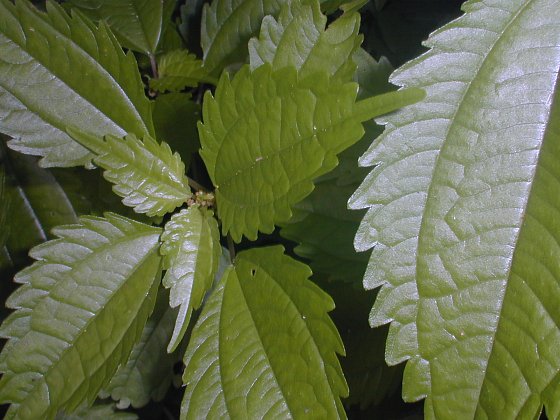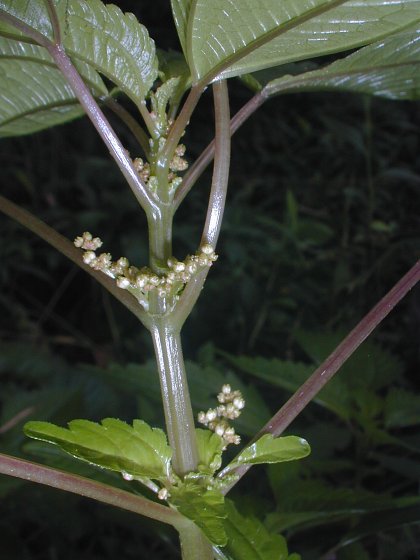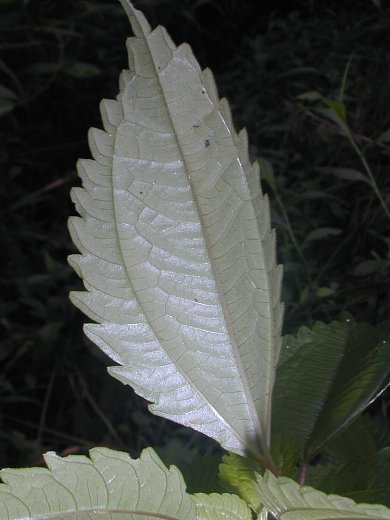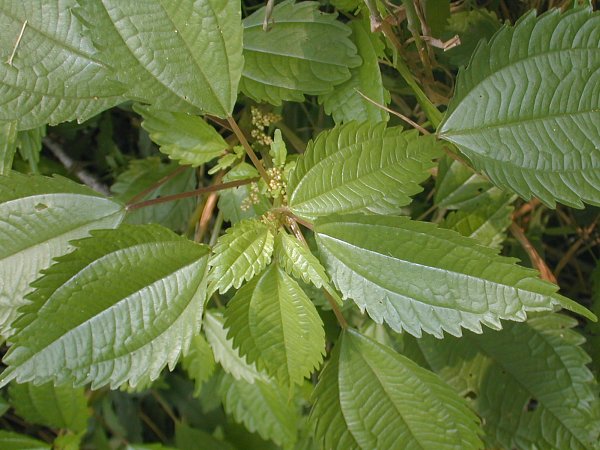Description: This annual plant is ½–2' tall, branching occasionally in the upper half. The stems are smooth, terete, glabrous, and translucent. They are light green, greyish green, or reddish green in appearance; some of the larger stems may be slightly ribbed. The opposite leaves are ¾–4" long and about one-half as much across. They are ovate, hairless, and coarsely serrated. Each leaf has a thin membranous texture with a prominent central vein and two conspicuous side veins. The upper surface is green or dark green, while the lower surface is light green or nearly white. The petioles of the leaves are quite long, frequently 1" in length or more.

From the axil of each upper leaf, there develops a narrow raceme of flowers up to 1" long. This raceme is usually shorter than the petiole, slightly curved, and more or less horizontal. Each plant has separate male and/or female flowers that are less than 1/8" (3 mm.) long, and they are either greenish white or greenish yellow. The male flowers have no petals, 4 sepals, and 4 stamens, while the female flowers have no petals, 3 sepals, and 1 pistil. Toward the inner surface of the sepals are small scales. The blooming period occurs from mid-summer to early fall, lasting about 1 month. There is no floral scent. Cross-pollination of the flowers is by wind. The tiny achenes are green, sometimes with black stripes. They can be blown about by the wind, and in this manner spread to new areas.

Cultivation:
The preference is light shade, moist to wet conditions, and rich
loamy soil. The foliage is little bothered by disease and is it is
usually quite attractive. Standing water is tolerated if it is
temporary.
Range & Habitat:
The native Clearweed is a common woodland plant that occurs in almost
all counties of Illinois (see Distribution
Map).
Habitats include poorly drained areas of upland forests, floodplain
forests, crevices in rocky canyons, and shady or partially shaded
wetland areas, including seeps, borders of small streams, and low areas
along vernal pools. The moist wooded areas where this plant occurs are
typically dominated by such deciduous trees as Silver Maple, Sugar
Maple, American Sycamore, River Birch, Green Ash, etc. Clearweed often
forms large colonies by reseeding itself.

Faunal Associations: The flowers are wind-pollinated, therefore they don't attract many insects. The caterpillars of the following butterflies feed on the foliage of Clearweed: Nymphalis milberti (Milbert's Tortoiseshell), Polygonia comma (Comma), Polygonia interrogationis (Question Mark), and Vanessa atalanta (Red Admiral). These caterpillars feed on other members of the Nettle family as well. The larvae of a moth, Cosmopterix pulchrimella (Beautiful Cosmopterix Moth), mine the leaves. An aphid, Pseudasiphonaphis corni, uses Clearweed as a summer host, where they suck juices from the stems and flowering stalks. This species is also one of the host plants of a polyphagous leafhopper, Empoasca recurvata.

Photographic
Location:
The plants were growing in a shady area along a small stream at
Meadowbrook Park in Urbana, Illinois.
Comments:
The most unusual characteristic of this plant is the translucency of
the foliage – this has been useful in biology classes to show the
uptake of liquids from the roots into the stems and leaves. A less
common species of Clearweed, Pilea fontana, has
stems that are less translucent and its achenes are black, rather than
green. Clearweed resembles other members of the Nettle family as well,
but it lacks the stinging hairs that can be found on Urtica
dioica (Stinging Nettle) and Laportea canadensis
(Wood Nettle). While Boehmeria cylindrica (False
Nettle) lacks stinging hairs, its stems aren't translucent and its
racemes of flowers are more erect and longer than Clearweed's racemes.